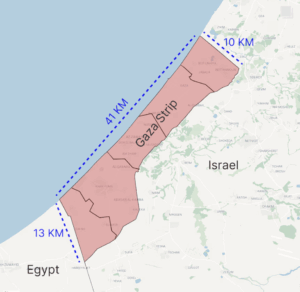Andrew L. Urban
Death, destruction and the rubble of the territory are a legacy of Hamas in Gaza. The vast amount of rubble in Gaza, estimated at over 51 million tonnes from the destruction of around 80% of the territory’s buildings and infrastructure, represents one of the largest debris management challenges in modern history.
In Khan Yunis alone (southern Gaza), 85% of the area is destroyed, generating 400,000 tonnes of street rubble, alongside 350,000 tonnes of unmanaged waste and widespread damage to water (300 km of networks) and sewage systems (75% affected). Northern areas like Gaza City are similarly reduced to “piles of rubble,” with families beginning to return post-ceasefire only to find their homes obliterated
Debris is laced with unexploded ordnance (UXO/EO), asbestos, hazardous waste, and explosive chemicals that have tripled soil pollution levels. Only 1.5% of Gaza’s pre-war 15,000 hectares of fertile farmland remains cultivable, threatening long-term food security.
Under the Gaza Debris Management Working Group (DMWG)—co-chaired by the UN Environment Programme (UNEP) and partners like UNDP, UN-Habitat, and the Palestinian Authority—the rubble will undergo a phased, risk-managed process rather than simple dumping. This aligns with broader reconstruction frameworks, including elements of the U.S.-brokered ceasefire deal emphasizing debris clearance to reopen roads and enable aid distribution.
Emergency removal in priority areas (e.g., hospitals, aid routes) using non-armored equipment and local teams, supported by explosive ordnance disposal (EOD) experts to minimize risks to workers and civilians. Pilot projects are already testing cost-effective methods in southern Gaza to clear paths for humanitarian convoys.
Debris will be processed at scale, with viable materials (e.g., concrete, metals) recycled for reconstruction—drawing from past Gaza programs where up to 80% has been reused. Hazardous elements like asbestos will be isolated and safely disposed of to prevent health risks.
Non-recyclable waste will go to designated sites, with UNRWA and partners handling solid waste collection for about 1.4 million people in 2025, expanding as access improves. Contaminated land, especially agricultural plots, will require decontamination to restore fertility, integrated into long-term environmental recovery.
Full rubble clearance is estimated to take 10 years and cost $1.2 trillion.
Rebuilding infrastructure, eg schools (90% damaged) and hospitals (94% damaged), will take an estimated 5 – 15 years and cost $4.5 trillion.
Soil pollution from explosives, collapsed irrigation (83% of wells destroyed) means land fertility restoration will take some 25 years.
These timelines assume sustained international funding and stability, with biannual reviews of DMWG guidance to adapt to on-ground realities.
Hamas expected and wanted a massive, destructive response from Israel to the carnage it inflicted on Israel on October 7, 2023. The intention was to turn international opinion against Israel for that response. It wanted tens of thousands of deaths to blame on Israel and Gaza tuned into rubble. As a bonus, many in the West took Hamas’ genocidal behaviour and threw the charge, unverified, against Israel. It has indeed won the propaganda war, as intended.

The Gaza Strip
The Gaza Strip, with a population of about 2.1 million, is 360 sq km in area, 41 kms long, 13 kilometres at its widest, about 5 kilometres at its narrowest, and about 10 kilometres at the top. To put that into context, it’s less than half the size of Canberra – population 483,000.
